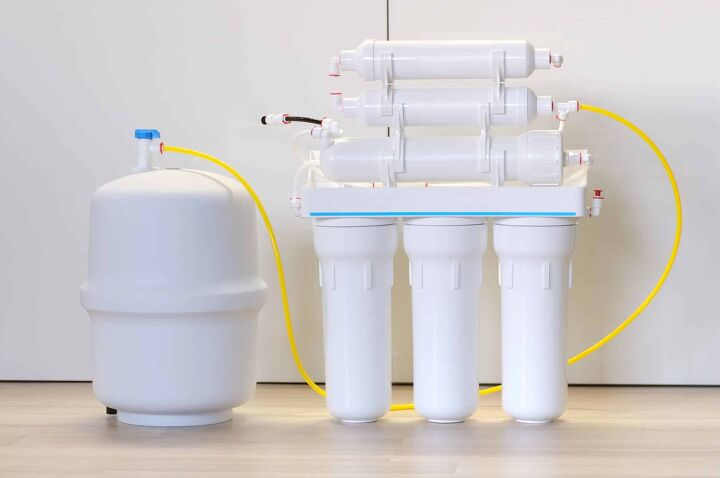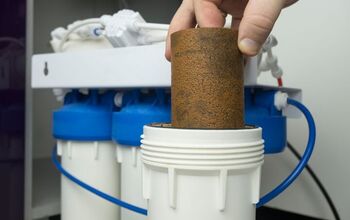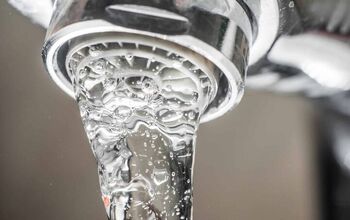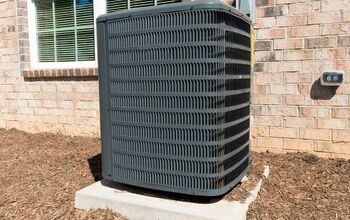How Much Does A Reverse Osmosis System Cost?

It’s no secret that drinking reverse osmosis water can have many health benefits. The higher quality water contains fewer contaminants and tastes better than regular water. The reverse osmosis filtration system is commonly sought out by many others because of these health benefits. Surprisingly, though, this filtration system isn’t expensive, as one would think.
The average cost of a reverse osmosis system is $350 for a tank system. Tankless reverse osmosis systems cost $1,250, on average, and that can filter water for 5 sinks. It costs an average of $12,000 to install point of entry systems, and simple point of use systems average $300.
Many factors play into the price of installing a water filtration system, such as this one. In this article, we will go through the different scenarios and the expenses associated with them. Another great thing about this type of system is its DIY friendly! We will cover the basics of self-installation as well.
Need a Water Treatment and Purification System Installed or Replaced?
Get free, zero-commitment quotes from pro contractors near you.

Exploring The Costs Of Installing A Reverse Osmosis Water Filtration System
Usually, individuals will choose the faucet filtration systems as these are cheaper. However, some people prefer to have a whole-home filtration system. Which one you want will determine the price that you will pay.
The price will depend on several factors, such as:
- The type of tank you choose, or if you decide to go tankless
- Point of entry vs. point of use
- Whether you DIY, or hire a professional
For a point-of-use system, you can expect to pay anywhere between $250 to $400. These are systems that filter the water through your drinking water from the faucet.
Some point of entry systems will run you $6,000 to $18,000. Although, the price point includes labor, as well as the cost for a larger home.
Cost of Reverse Osmosis System Options | |
Point of Use | Point of Entry |
$250 – $400 | $6,000 – $18,000 |
Tank vs. Tankless: What Is The Price Difference?
Tankless RO Systems
A tankless RO (Reverse Osmosis) system is going to cost you far more than one that requires a tank. However, some people prefer the tankless option due to the sleek, compact design.
For a tankless RO, it filters the water on demand. Filtration on demand means that you don’t need to wait for a tank to fill. Also, it takes up less room.
These products will cost between $500 and $2,000 per unit. So, for example, for five sinks, this will cost between $2,500 and $10,000.
Tanked RO Systems
While a tank will take up more room, it will be a more budget-friendly option compared to the tankless system.
The way a tank works is the receptacle will fill up with RO filtered water. Once that tank is empty, though, you will need to wait for it to refill.
These products will run you about $200 to $1,100 per installation. So again, if you have five sinks, this will cost between $1,000 and $5,500.
Tankless VS. Tank Cost Difference | |
Cost Per Unit | |
Tankless Systems | Tanked Systems |
$500 – $2,000 | $200 – $1,100 |
These prices reflect the average cost. This can be less or more, depending on the system you choose to purchase.
Point Of Entry vs. Point Of Use: The Overall Differences And Cost
There are several differences between the point of entry systems and the point of use systems. It’s important to understand the overall difference of both of these as well as the cost difference so that you can choose which one best suits you and your needs.
Point Of Entry
A point of entry system, or POE, is installed into your main water line. This is where your water is dispersed throughout the house.
When you install a POE system, it filters all the water that comes through your home. This means that you have RO filtered water in your toilet, as well as your bathtub. Some people may think this is extreme, although there are some reasons you may need this.
If your water is contaminated, you may want to think of installing a whole-home RO system. RO will solve several contamination issues, including:
- Metals
- Lead
- Viruses
- Bacteria
- Chemicals
- And Other contaminants.
If you are in an area where your water has these contaminants, you should install a whole-home system.
The cost of a point of entry system will run about $6,000 to $18,000. However, it depends on the system you install. This price includes installation fees, but this is DIY friendly. If you do it yourself, you are potentially looking at $3,000 to $10,000.
Point Of UsePoint of use systems is different from POE in the way that they operate. Rather than filtering the entire home, they filter the sink where you install them.
For instance, if you don’t drink water from the bathroom sink, you don’t need a unit in there. You also will not be bathing in filtered water. The point of use is purely to ingest reverse osmosis filtered water, not shower in, or launder with.
The cost of a point of use system is about $250 to $400 per unit. Of course, this price differs depending on the type of unit that you get. Some of these can even run up to $10,000 per unit. Although, that is unusual for someone to buy for residential use.
The Cost Difference Of Doing it Yourself
All the above prices talked out in this guide include the installation fees and labor costs of plumbers. Now, how much would it be if you did it yourself? You could save a lot of money if you opt-out of professional installation.
The cost to do it yourself will be the price of what system you’re installing. This can be as low as $75 per unit, to $800 per unit. This depends on whether you choose the point of entry or a point of use system.
DIY vs. Professional Installation | |
Average Cost Per Point of Use Unit | |
DIY | Professional |
$75 – $300 | $250 – 400 |
DIY vs. Professional Installation | |
Average Cost of Point of Entry | |
DIY | Professional |
$3,000 – $6000 | $6,000 – $18,000 |
As you can see, the choice to do it yourself could save you quite a bit of money.
Basic Instructions Of Installing A DIY Reverse Osmosis Water Filtration System: Point Of Use And Point Of Entry
Point Of Use
- Shut off the water. Close the cold water shut off valve
- Turn on the faucet. Turn your cold water on to make sure the water is not still running
- Disconnect the water line from the shutoff valve from the cold water
- Tighten the water supply fitting to the cold shut off valve using your hand only.
- Drain the water. Use the water draining kit to drain the water from the reverse osmosis filters.
- Take apart the drainpipe. Disassemble the sink drainpipe from the tailpiece of the sink. Clean the tailpiece.
- Install the drain adapter directly to the sink tailpiece.
- Put the drain tubing connector onto the drain adapter, turning it 45 degrees. Tighten the nut.
- Assemble the P trap to the drain adapter and the other fittings as well
- Tighten all the connections, but make sure they are not too tight, or they may break if they are plastic.
If you have a soap dispenser built-in or a hole through the back of your sink, you can use this. However, if you don’t, you will need to drill a hole.
The hole should be about 1 ¼ inch in diameter.
Step 3: Installing The System- Secure the mount to the sink. Mount the faucet base to your countertop or your sink by sliding the toggle bolts through the hole. Tighten the screws to secure it to the sink.
- Insert the tubing. Feed the tubing attached to the body of your system through the hole.
- Connect everything. Connect the other tubing into the filtration tank. Check to make sure the tubing is free of damage and secure your faucet.
Since each system is different, these instructions give you a general idea of what it takes to self-install. It’s relatively easy if you have the right tools. Check your user manual for a list of tools you will need and the instructions for your system.
Point Of Entry
The point of entry installation is a bit trickier. You must shut off the main water supply and cut the line. After you cut the line, you will want to re-route it through your system. Also, make sure that you allow adequate soaking time for your tank. You may want to do this the day before you plan to install your system.
The point of entry system is vastly different in the way they are installed, but they’re easy to do yourself. Grab the instructional manual and read through the steps to ensure you do them correctly. Reading the instructions will help to ensure you install them correctly according to your system.
Related Questions
How much will a Reverse Osmosis Filtration System save me over time? Save Me Over Time?
On average, a family of four will purchase over $4,000 of bottled water in one year. A RO water filtration system costs only about $100 to replace the filters each year. That’s a $3,900 annual savings. So, while it may be pricey to install, the amount of money it will save you is worth it!
Is a whole house reverse osmosis system necessary?
A whole house reverse osmosis water system is not necessary unless you have specific water problems. If you have contaminants in your water and you’re hooked up to the city, or you have any hardness, chlorine, lead, or chloramines, then you would benefit from a whole house system. Other than that, it’s entirely unnecessary.
Do you need a water softener for reverse osmosis?
No, you do not need a water softener for a reverse osmosis system. However, if you’re installing the system because you have water hardness issues with no other problems, then perhaps using a water softener would help instead. That way, you don’t waste so much water. Water softeners are an economical solution as opposed to the reverse osmosis system.
Need a Water Treatment and Purification System Installed or Replaced?
Get free, zero-commitment quotes from pro contractors near you.

Installing A Filtration System Yourself Is Worth All The Effort!
Saving hundreds or even thousands of dollars by installing yourself is worth your time! Not only does it save you money on installation prices, but it saves money over time as well.

Heather is a passionate writer who loves anything DIY. Growing up, she learned everything from home repairs to design, and wants to share her tips with you. When she's not writing, she's usually hiking or searching for her next DIY project.
More by Heather Robbins














![10 Best Electric Pressure Washers – [2022 Reviews & Guide]](https://cdn-fastly.upgradedhome.com/media/2023/07/31/9070600/10-best-electric-pressure-washers-2022-reviews-guide.jpg?size=350x220)

![How To Reset A Whirlpool Cabrio Washer [In 5 Easy Steps!]](https://cdn-fastly.upgradedhome.com/media/2023/07/31/9076531/how-to-reset-a-whirlpool-cabrio-washer-in-5-easy-steps.jpg?size=350x220)




![Cost To Drill A Well [Pricing Per Foot & Cost By State]](https://cdn-fastly.upgradedhome.com/media/2023/07/31/9074980/cost-to-drill-a-well-pricing-per-foot-cost-by-state.jpg?size=350x220)





